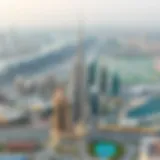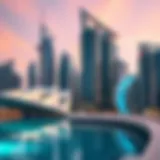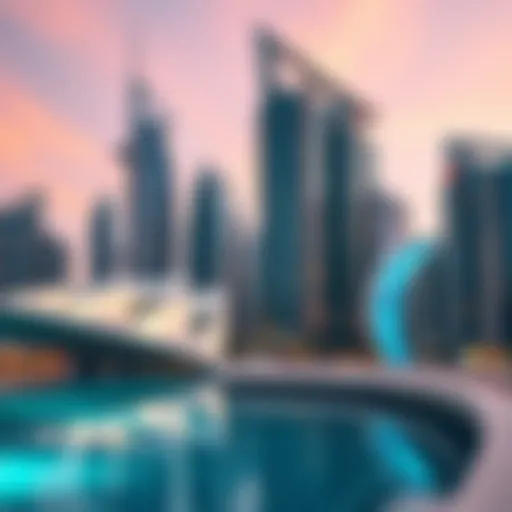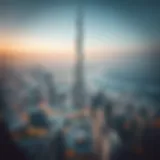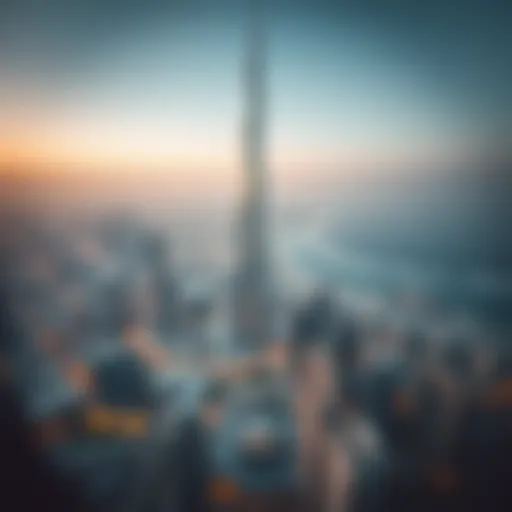Exploring Green Land Quasis in Dubai's Real Estate


Intro
Dubai has become a sprawling urban jungle, where glittering skyscrapers meet sprawling deserts and vibrant communities. Yet, hidden within this magnificence lies a crucial aspect often overshadowed by concrete and glass - the Green Land Quasis. These green havens play a vital role in fostering an environmentally conscious real estate sector and enhancing the overall quality of life for Dubai's residents.
As urbanization continues at an unprecedented pace, the significance of integrating green spaces cannot be overstated. The concept of Green Land Quasis encompasses parks, green corridors, and sustainable urban landscaping, serving as the lungs of the city. They not only offer much-needed respite from the hustle and bustle of city life but also have a resounding impact on property values and investment opportunities.
In this article, we delve deep into the Green Land Quasis within the context of Dubai's real estate landscape. From current market trends to investment opportunities shaped by these essential green spaces, we aim to provide a comprehensive understanding that resonates with investors, homeowners, and policy-makers alike.
Let's take a closer look at how these green pockets are transforming the city's skyline and how they intertwine with the fabric of Dubai's real estate.
Intro to Green Land Quasis
Understanding the notion of Green Land Quasis is pivotal when exploring Dubai's evolving real estate landscape. This intersection of urban development and environmental consciousness highlights how integrating green spaces can enhance not just the aesthetics of property but the very way inhabitants interact with their surroundings.
The significance of Green Land Quasis lies in its multifaceted benefits. Foremost, these areas contribute to a healthier atmosphere by improving air quality and promoting biodiversity within urban settings. Furthermore, properties adjacent to green spaces often carry a higher value, as buyers are increasingly looking for environments that offer both comfort and a semblance of nature.
When considering this topic, it's essential to reflect on several key elements:
- The potential for reduced heat islands in sprawling urban centers.
- An increase in community engagement, where parks and gardens become hubs for social activities.
- The impact of these spaces on stress reduction and overall well-being, thus influencing both physical and mental health.
In addition, Green Land Quasis are not merely an aesthetic addition to Dubai's skyline. They symbolize a commitment to sustainability at a time when climate change concerns are paramount. Investors and property developers stand to gain by adjusting their projects to accommodate these spaces, ensuring long-term viability in a competitive market.
"Incorporating green spaces into urban planning is not simply an add-on; it's a necessity for the future of our cities."
As we delve deeper, it becomes apparent that tracing the evolution of green land concepts provides insight into how these areas have transitioned from mere considerations to essentials in modern urban planning.
The Importance of Green Spaces in Urban Areas
Green spaces have become more than just patches of grass or clusters of trees tucked away in concrete jungles; they represent a crucial component of modern urban planning. Especially in cities like Dubai, where rapid development often leads to a densely packed environment, the value of green areas can't be overstated. Integrating nature into urban settings is not merely an aesthetic choice; it holds substantial environmental, economic, and cultural implications. As such, understanding the significance of these spaces is vital for property investors, homeowners, and city planners.
Environmental Benefits
The environmental advantages of green spaces are numerous and diverse. Firstly, they help improve air quality significantly. Urban areas often grapple with high levels of pollution, and areas filled with vegetation can help mitigate this. Trees and plants absorb carbon dioxide while releasing oxygen—this fundamental process is essential for healthier air and a balanced ecosystem.
Moreover, green spaces play a pivotal role in biodiversity. They serve as habitats for various species, fostering local fauna and flora that might otherwise struggle to survive in urban settings. This not only aids in preserving wildlife but also reinforces ecological stability, which is crucial for a city like Dubai that faces climate challenges.
- Stormwater management: Green spaces can also absorb rainwater, reducing runoff and lowering the risk of flooding in urban environments. This is especially important in arid regions where water scarcity is a continuing dilemma.
- Urban heat island effect: By providing shade and releasing moisture into the air through transpiration, parks and gardens can help to lessen the urban heat island effect, which can lead to lower overall temperatures in the vicinity.
In building a sustainable future, these environmental benefits of green spaces are essential in counteracting some of the challenges posed by urbanization.


Economic Impact on Property Values
When it comes to property values, the presence of green spaces can often be a game changer. Numerous studies suggest that homes located near parks or green areas tend to hold their value better over time than those that are not. Buyers are more inclined to pay a premium for properties that offer proximity to nature, which translates to considerable gains for property owners.
Real estate agents frequently highlight green spaces as a significant selling point. Buyers are increasingly looking for an environment that promotes a balanced lifestyle—a place where they can unwind, socialize, and reconnect with nature. Properties nestled within or close to green zones can fetch up to 15% more than their counterparts situated in less green locales.
- Increased foot traffic: For commercial properties, green spaces often draw more foot traffic. Businesses positioned near parks or gardens can see an uptick in patronage as the spaces attract visitors.
- Enhanced community appeal: Urban areas with ample green spaces tend to attract families and professionals alike, enhancing the overall community appeal and driving demand.
Consequently, integrating such spaces into future developments not only contributes to social well-being but also positively influences the economic landscape of Dubai's real estate market.
Cultural and Aesthetic Considerations
Culturally, green spaces can symbolize community and connection. They act as communal spaces where people gather, socialize, and celebrate events, fostering a sense of belonging and identity. Parks, with their vibrant trees, flowers, and open areas, can be venues for festivals, farmers' markets, and cultural gatherings, thereby enriching the social fabric of Dubai.
Aesthetically, the presence of greenery adds beauty and variety to the urban landscape, transforming what could be a monotonous cityscape into a more inviting and visually appealing environment. Lush parks and gardens can lead to increased feelings of happiness and well-being among inhabitants. The sight of blooming flowers, the sound of rustling leaves, and the feeling of soft grass underfoot can evoke joy, making daily interactions more pleasant.
- Artistic inspiration: Artists and photographers often draw inspiration from green spaces, leading to a growing body of work that reflects the interplay of nature and urban life.
- Historic significance: Many cultures correlate nature with beauty and tranquility. This mindset can foster respect for the environment and engage communities in protecting these spaces.
Current Trends in Dubai's Real Estate Market
The real estate landscape in Dubai is an evolving tapestry, where green initiatives are becoming seamlessly woven into the fabric of new developments. With the growing emphasis on sustainability, the integration of green spaces is not just a trend but a necessary shift for urban development. Understanding current trends provides investors, homeowners, and industry analysts with insight into how these changes can transform property values and enhance quality of life.
Integration of Green Spaces in New Developments
The concept of integrating green spaces into new developments is gaining traction across Dubai. Developers are responding to a heightened awareness and demand for eco-friendly environments. Properties are increasingly adorned with lush parks, community gardens, and landscaped areas. This shift isn't merely aesthetic; it significantly impacts community well-being and property appeal.
In practical terms, this means that prospective buyers are now prioritizing homes that offer proximity to these verdant expanses. Properties set against the backdrop of nature can achieve better appreciation in value compared to those in concrete-dominated environments. Moreover, green spaces provide a refuge from the bustling urban life, offering residents a healthier way to unwind. The metrics suggest that homes near parks or gardens can often fetch a higher price, justifying the developer’s investment in landscaping.
- Enhanced Quality of Life: Access to green spaces fosters physical and mental well-being. Studies suggest that residents near parks engage in more outdoor activities.
- Attractiveness to Investors: Investors take a keen interest in developments featuring landscaped areas, interpreting them as indicators of potential long-term value growth.
- Community Cohesion: Green spaces promote social interaction, drawing people together for activities and community events.
Policies Promoting Sustainability
Policies supporting sustainability are at the forefront of Dubai's real estate transformation. The Dubai government recognizes that urban growth must be tempered with ecological responsibility. New regulations are encouraging developers to incorporate sustainable practices in their projects, thus promoting a greener future for the city.
Among such initiatives, the Dubai Green Building Regulations play a pivotal role. These regulations set standards which builders must follow, focusing on energy efficiency, waste management, and water conservation. Compliance with these regulations often comes with incentives, such as tax breaks or expedited project approvals.
Here are some key policies influencing current real estate trends:
- Energy Efficiency Requirements: New buildings are now mandated to meet strict energy efficiency standards, reducing overall operational costs for homeowners.
- Encouragement of Renewable Energy: Many developments are designed with solar panels and other renewable energy sources, lessening the reliance on traditional power sources.
- Water Conservation Initiatives: Technologies aimed at reducing water consumption, such as greywater recycling systems, are integrated into new builds, securing sustainability in the long term.
"The future is green, and Dubai is taking vital steps to make it a reality."
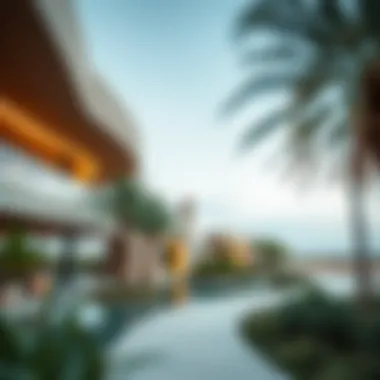

In summary, the current trends in Dubai's real estate market highlight an unmistakable shift towards greener and sustainable practices. As developers wisely adapt to these trends, they set the stage for a more vibrant, efficient, and livable environment.
Challenges and Opportunities
In the vast expanse of Dubai's real estate landscape, the introduction and integration of Green Land Quasis has brought forth a myriad of challenges and opportunities. Addressing these elements is essential not only for developing sustainable urban spaces but also for improving the quality of life for residents. The quest for balance between urban growth and environmental conservation is likened to walking a tightrope; it requires careful consideration, innovation, and a thorough understanding of the real estate market’s dynamics.
Limitations in Space and Urban Planning
One of the most pressing issues in Dubai’s urban planning is the limitation of space. The city, known for its awe-inspiring skyline and sprawling developments, is also challenged by its geographical constraints. The rapid population growth has intensified the demand for residential and commercial spaces, often overshadowing the need for green areas.
- High Demand: As existing infrastructures are stretched thin, there’s a relentless push to maximize land use. For developers, this often translates to high-rises and sprawling urban complexes.
- Planning Regulations: City planners are sometimes caught in a bind. While regulations encourage the inclusion of green spaces, the reality often leads to minimal compliance, as profit margins bear more appeal.
- Undeveloped Land Scarcity: As prime land is developed, the options for integrating spacious, meaningful green areas diminish. This results in small patches of grass or ornamental plants that do little to remedy environmental concerns.
Despite these challenges, there are avenues for enhancing green spaces. Some developers are rethinking their approach – utilizing rooftops, vertical gardens, and even transforming parking lots into green zones. These adaptations signify potential benefits that can make urban living more sustainable in a city that thrives on modernity.
Public Perception and Engagement
Public perception regarding Green Land Quasis plays a pivotal role in shaping policies and initiatives. While the authorities recognize the advantages of green spaces, the acceptance and engagement of the citizens are equally vital. Here are some key points to consider:
- Community Awareness: Many residents are still unaware of the ecological benefits stemming from green spaces. Educational programs and community involvement foster appreciation and motivate citizen engagement.
- Aesthetic Value: The look and feel of neighborhoods surrounding parks or gardens significantly influence property values. As a result, homeowners might push for more green initiatives.
- Citizen Participation: Platforms for community feedback can drive the demand for green spaces. Authorities that listen and act upon residents’ desires create a more relatable urban environment.
By fostering a culture of engagement, the city can effectively integrate public preferences into its planning strategies.
"Sustainable development is not just about preserving the physical environment, but also cultivating a mindset among residents that embraces change towards greener living."
While hurdles abound in the integration of Green Land Quasis, the opportunities to transform Dubai's landscape are equally robust. By addressing spatial limitations with innovative solutions and involving the public in the debate, Dubai's real estate market has the potential to redefine luxury living. The interplay of challenges and opportunities offers a roadmap for a future where green spaces and urban living coexist harmoniously.
Case Studies of Successful Implementation
When talking about Green Land Quasis in Dubai, examining successful implementation is key to understanding their impact. By looking at actual projects, investors and homeowners can gauge the effectiveness of integrating green spaces into urban areas. Not only do these projects illustrate innovative design and sustainable practices, but they also highlight the benefits of enhancing property values and community well-being.
Notable Projects in Dubai
In the past decade, several projects in Dubai have set the stage for integrating green spaces effectively within urban environments. Here are a few noteworthy examples:
- Dubai Marina: This vibrant area has successfully orchestrated the balance between high-rise living and greenery. With parks and waterfront promenades, residents enjoy a lifestyle that encourages outdoor activities. The green spaces do not just beautify the area; they substantially increase property values. According to various surveys, apartments with direct views of the marina tend to command higher prices than those without.
- The Sustainable City: This project is an exemplar of eco-friendly living. Designed with sustainability at its core, it features solar panels, organic farms, and extensive green spaces. This community not only promotes biodiversity but also allows residents to live in harmony with nature. The Sustainable City showcases how environmental responsibility can coalesce with high property demand, making it a sought-after residential option.
- Al Barsha Pond Park: This park has become a green jewel amidst the urban sprawl. With its large pond, cycling and jogging paths, it enhances quality of life for residents and offers a tranquil escape from the hustle and bustle of city life. This park continuously sees increased foot traffic, which has positively influenced the surrounding property market by attracting families and individuals seeking a vibrant community atmosphere.
Through these examples, it is clear that well-executed green spaces in Dubai don’t merely serve aesthetic purposes; they create thriving communities that elevate surrounding property values and improve overall quality of life.
Comparative Analysis with Global Trends
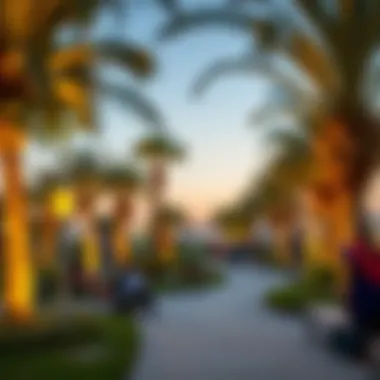

Looking at successful projects worldwide, it's evident that Dubai is not alone in recognizing the value of green spaces. Cities like Singapore, Copenhagen, and Vancouver have long emphasized the importance of integrating nature into urban life. Here’s a closer look at how Dubai’s initiatives compare to these global trends:
- Sustainable Urban Planning: Cities globally are shifting towards planning that incorporates nature. Singapore’s Gardens by the Bay is a stunning example. Similarly, Dubai’s projects like the Dubai Creek Harbour emphasize sustainability, echoing global trends but often with a unique blend of luxury and functionality.
- Community Engagement: In many successful international projects, community involvement plays a crucial role. For instance, Toronto's High Line, now a famous park built on an old railway, highlights community participation in urban rejuvenation. While public engagement in Dubai is still developing, initiatives like the Dubai Urban Planning Organization are looking to incorporate community feedback actively.
- Technological Integration: Global standards for urban green spaces often use tech for environmental monitoring and engagement. Projects in cities like Barcelona use smart technology to maintain green areas effectively. Dubai, too, is starting to adopt smart solutions, incorporating IoT for water management in gardens and parks.
As Dubai continues to innovate, drawing from successful global practices while blending them into its unique context, it has the potential to lead the way in sustainable urban development. The integration of these case studies into the cityscape not only promises enhanced living conditions but also demonstrates a commitment to responsible urban development and sustainability.
The Future of Green Land Quasis in Dubai
The future of Green Land Quasis in Dubai reflects a crucial shift in urban planning that aims to harmonize natural spaces with the fast-paced development of the city. The undeniable importance of integrating greenery into the urban fabric is becoming clearer. Green spaces aren’t merely an aesthetic choice; they catalyze environmental stewardship, community engagement, and economic vitality.
Looking ahead, one finds it hard not to feel optimistic about how these green arenas will reshape the fabric of Dubai's real estate landscape. As regulations and public sentiment lean more towards sustainability, developers are realizing that green land concepts can significantly enhance attractiveness and desirability of properties. This adaptation undoubtedly comes with benefits, including improved quality of life for residents and increased property values.
Predicted Trends and Developments
Several trends are emerging that suggest a promising future for Green Land Quasis. First, mixed-use developments are gaining traction. Combine residential areas with green parks, walking paths, and recreational facilities. These projects are poised to address the increasing need for outdoor spaces, especially as urban dwellers often crave a respite from concrete jungles.
Another anticipated trend is the rise of vertical gardens and green rooftops. As the city expands upward, integrating flora into the architecture can yield impressive benefits, from enhancing air quality to reducing heat absorption. Also, further attention will likely be paid to creating urban wildlife corridors, ensuring that native species thrive and contribute to biodiversity.
- Mixed-use developments are on the rise.
- Vertical gardens become commonplace on buildings.
- Wildlife corridors are incorporated into urban design.
In addition to these prevailing movements, laws will likely continue evolving to promote sustainability. Regulations encouraging integrating more parks and green zones into new developments can provide developers with the green light they need to experiment and innovate.
Impact of Technological Innovations
Technological advancements will significantly influence the future of Green Land Quasis in Dubai. Today, innovations such as smart irrigation systems and drone-assisted gardening are paving the way for more efficient and sustainable landscape management. With smart tech, it’s possible to optimize watering schedules based on real-time weather data, minimizing water waste in a region already known for its scarcity of water resources.
Furthermore, sustainable materials and construction techniques are gaining more attention. Companies are exploring eco-friendly building materials that can further blend nature with urbanity. Solar panels integrated into the landscape design can provide energy while enhancing the beauty of green spaces.
"Embracing technology not only complements sustainability efforts but also sets a precedent for future developments that prioritize livability and ecological balance."
As Dubai moves forward, it should become increasingly clear that the intertwining of nature and urban life isn't merely advantageous; it is essential. People are emphasizing quality of life and environmental responsibility, and with these technological breakthroughs, the future of Green Land Quasis seems not only feasible but wholly achievable.
Finale
The culmination of this exploration into the Green Land Quasis in Dubai signifies more than just an examination of physical spaces; it paints a vivid picture of how urban life can harmonize with nature. The integration of green spaces within real estate developments isn’t merely a trend; it’s morphing into an essential strategy in urban planning that has profound implications for sustainability, community well-being, and property values.
Summary of Key Insights
Several vital insights have emerged throughout this article:
- Environmental Imperatives: Green spaces significantly contribute to pollution reduction and biodiversity, making urban settings more livable and attractive.
- Economic Viability: Data indicates that properties near green landmarks often enjoy higher market values and quicker sell-through rates. This correlation underscores the importance for investors to consider green attributes in their investment evaluations.
- Urban Cohesion: Parks and gardens create communal hubs, fostering connectivity among residents, enhancing a sense of belonging, and creating vibrant community interactions. In essence, these spaces stand as a cornerstone for social harmony.
Final Thoughts on the Significance of Green Spaces
The forward momentum of Dubai’s real estate landscape heavily relies on the wise integration of green land quasis. These green elements are not a peripheral aspect of development but rather, the backbone of innovative urban design strategies. As more developers pivot their focus to eco-friendly initiatives, the long-term benefits are becoming crystal clear. From improved air quality to elevated life satisfaction levels, the impact of enhanced green spaces is tremendous.
All stakeholders, including investors, public planners, and residents, should recognize the value that green land quasis hold not just in the present, but for future generations. The goal is a sustainable urban environment that skillfully balances concrete with green canopy, creating a dynamic, thriving cityscape that provides emotional and physical benefits for all. Ultimately, the message is clear: investing in green spaces is not just about aesthetics—it’s about crafting a better, healthier, and more prosperous city for everyone.










